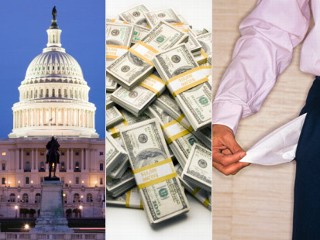in caricamento ...
FED, quantitative easing e simpatiche coincidenze
Nulla di nuovo. La riunione della FED di ieri non ha portato nulla di nuovo.
Per carità, io mi aspettavo ben poco dal meeting della Federal Reserve di ieri. Tassi che sarebbero restati in variati, menzioni alla ripresa economica. Tutto coma da copione.
Però qualche spunto interessante, occorre ammetterlo, nn è mancato.
Innanzitutto il buon capo della Federal Reserve (FED) Ben Bernanke ha ammesso una cosa, che oserei definire in questo modo: la giapponesizzazione dell’economia.
“I tassi rimarranno bassi per un periodo eccezionalmente lungo”.
Messaggio chiaro ed esplicito. Se la memoria non mi tradisce, significa inflazione che non riparte, significa economia che non gira, significa che la ripresa latiterà ancora per molto…Ma come… Tutto questo cozza in modo clamoroso con la realtà dei fatti. Il mercato ha una valanga di liquidità a disposizione, liquidità che è stata anche protagonista nonché causa del rally delle borse.
E se riparte il ciclo economico, secondo me è indiscutibile il fatto che questa valanga di liquidità prenderà il sopravvento generando inflazione.
Permettetemi una piccola parentesi. Uno dei personaggi più particolari ma validi del mondo finanziario, Marc Faber, ha detto qualche giorno fa: “The world has not seen the end of the financial crisis and the recent surge in markets was a result of excess liquidity coming from central banks. If you pump money into the system and you create large fiscal deficits, you create volatility.” “.. We’ve seen an intermediate low in March, we’ll rally for a year or so or maybe 18 months — the ultimate crisis will happen much later, and the ultimate crisis would clean the system” “..“I am 100 per cent sure the US will go into hyperinflation. Buy a US$100 bond and frame it to teach your children about inflation by watching the US bond value diminish to almost nothing over the next 20 years.”
Mettiamola così…qui c’è qualcuno che non c e la conta troppo giusta.
Per Bernanke abbiamo la fine della recessione, però non ci sarà uanc rescita virtuosa, perché i tassi saranno ancora bassi a lungo.
Vabbè, quante volte ho parlato del teatrino e del giochino psicologico attuato dai potenti dell’economia e della politica mondiale?
Quantitative easing? Slowly…
Altro passaggi interessante: Il ricorso al quatitative easing è stato rallentato, per garantire un periodo di transizione morbida. Il tutto suona a mò di manovra “tutto fumo e niente arrosto”. Ovvero dico una cosa al mercato senza mai renderla operativa. Altro giochino psicologico ed estetico. Brutte news per chi quindi sperava in una manovra di quatitative easing più aggressiva ed efficace.
Il confronto
Ora però vi porto a conoscenza di due interessanti testi.
L’autore in entrambi i casi è la Federal Reserve. Anzi, per meglio dire il FOMC.
E’ il cosiddetto FOMC Statement.
Eccovi il testo del 24 giugno scorso.
Information received since the Federal Open Market Committee met in April suggests that the pace of economic contraction is slowing. Conditions in financial markets have generally improved in recent months. Household spending has shown further signs of stabilizing but remains constrained by ongoing job losses, lower housing wealth and tight credit. Businesses are cutting back on fixed investment and staffing but appear to be making progress in bringing
inventory stocks into better alignment with sales. Although economic activity is likely to remain weak for a time, the Committee continues to anticipate that policy actions to stabilize financial markets and institutions, fiscal and monetary stimulus, and market forces will contribute to a gradual resumption of sustained economic growth in a context of price stability. The prices of energy and other commodities have risen of late. However, substantial resource slack is likely to dampen cost pressures, and the Committee expects that inflation will remain subdued for some time. In these circumstances, the Federal Reserve will employ all available tools to promote economic recovery and to preserve price stability. The Committee
will maintain the target range for the federal funds rate at 0 to 1/4 percent and continues to anticipate that economic conditions are likely to warrant exceptionally low levels of the federal funds rate for an extended period. As previously announced, to provide support
to mortgage lending and housing markets, and to improve overall conditions in private credit markets, the Federal Reserve will purchase a total of up to $1.25 trillion of agency mortgage-backed securities and up to $200 billion of agency debt by the end of the year. In addition, the Federal Reserve will buy up to $300 billion of Treasury securities by autumn. The Committee will continue to evaluate the timing and overall amounts of its purchases of securities in light
of the evolving economic outlook and conditions in financial markets. The Federal Reserve is monitoring the size and composition of its balance sheet and will make adjustments to its credit and liquidity programs as warranted.
Voting for the FOMC monetary policy action were: Ben S. Bernanke, Chairman; William C. Dudley; Elizabeth A. Duke; Charles L. Evans; Donald L. Kohn; Jeffrey M. Lacker; Dennis P. Lockhart; Daniel K. Tarullo; Kevin M. Warsh; and Janet L. Yellen.
Ora eccovi il testo di ieri, 12 agosto 2009 (cambio il colore sennò sembra un copia-incolla del testo sopra.)
Information received since the Federal Open Market Committee met in June suggests that economic activity is leveling out. Conditions in financial markets have improved further in recent weeks. Household spending has continued to show signs of stabilizing but remains constrained by ongoing job losses, sluggish income growth, lower housing wealth, and tight credit. Businesses are still cutting back on fixed investment and staffing but are making progress in bringing inventory stocks into better alignment with sales. Although economic activity is likely to remain weak for a time, the Committee continues to anticipate that policy actions to stabilize financial markets and institutions, fiscal and monetary stimulus, and market forces will contribute to a gradual resumption of sustainable economic growth in a context of price stability. The prices of energy and other commodities have risen of late. However,
substantial resource slack is likely to dampen cost pressures, and the Committee expects that
inflation will remain subdued for some time. In these circumstances, the Federal Reserve will employ all available tools to promote economic recovery and to preserve price stability. The Committee will maintain the target range for the federal funds rate at 0 to 1/4 percent and continues to anticipate that economic conditions are likely to warrant exceptionally low levels of the federal funds rate for an extended period. As previously announced, to provide support to mortgage lending and housing markets, and to improve overall conditions in private credit markets, the Federal Reserve will purchase a total of up to $1.25 trillion of agency mortgage-backed securities and up to $200 billion of agency debt by the end of the year. In addition, the
Federal Reserve is in the process of buying $300 billion of Treasury securities. To promote a smooth transition in markets as these purchases of Treasury securities are completed, the Committee has decided to gradually slow the pace of these transactions and anticipates that the full amount will be purchased by the end of October. The Committee will continue to evaluate the timing and overall amounts of its purchases of securities in light of the evolving economic outlook and conditions in financial markets. The Federal Reserve is monitoring the size and composition of its balance sheet and will make adjustments to its credit and liquidity programs as warranted.
Voting for the FOMC monetary policy action were: Ben S. Bernanke, Chairman; William C. Dudley; Elizabeth A. Duke; Charles L. Evans; Donald L. Kohn; Jeffrey M. Lacker; Dennis P. Lockhart; Daniel K. Tarullo; Kevin M. Warsh; and Janet L. Yellen.
Che ve ne pare? Certo che alla Federal Reserve si ammazzano proprio nel compilare questi documenti, inondandoli di novità e di importanti decisioni…
STAY TUNED!




